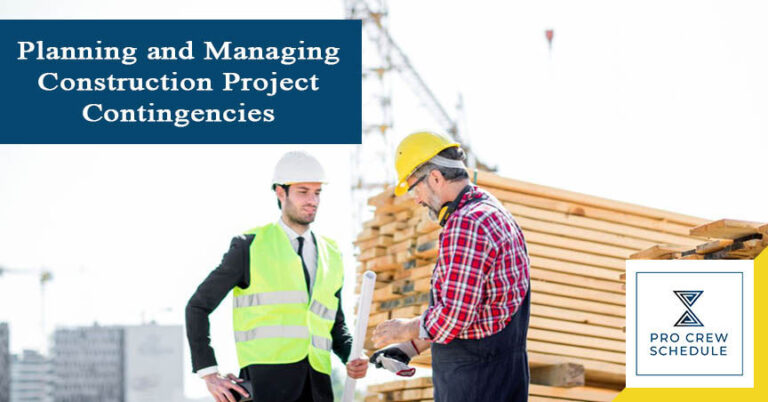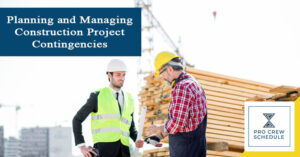One of the challenges when managing construction is planning and managing your project’s budget as close as possible to the actual costs. The project will be completed much easier and faster if the budget is more accurate. However, the construction industry is highly volatile – entirely unknown and prone to many risks and delays. To be able to deal with possible changes, it is essential to plan for budget contingencies and allowances. These can give you some wiggle room and help you prepare for unexpected costs.
In this article, let us look at the definition of project contingency, its types and benefits, and how you can efficiently and effectively manage it.
What is Construction Project Contingency?
In construction, a contingency gives you a backup plan or safety net if something happens. For example, when a price increases, contingencies can help protect profits by allowing you access to funds without hurting your bottom line.
Usually, a contingency is a set percentage or fixed amount of money to cover costs not planned for during the project. It can also be written into the contract for a material or service, but the specifics, like price and quantity, are unknown when the contract is signed.
Building allowances help you determine how much the project will cost in the worst-case scenario. It is essential to consider this when making your budget early on in the project before you make any building choices.
Why Are Contingency Plans Important?
As general contractors or project managers, one of the hardest things is ensuring that each job’s income, budget, and costs are balanced so that the cash flow and profitability remain stable. It is critical that estimators can accurately forecast how much the materials, labor, and work from subcontractors will cost. Cost estimates like these can come from bids from vendors and subcontractors, but they are usually on the primary budget months before the work starts. Since then, prices and costs have changed, turning that forecast into a guess.
This is where budget contingencies come in. Unforecasted or unbudgeted increases in costs, no matter how small, can quickly cut into your profit margins. Construction contingencies are essential because they make sure that the finances do not get messed up by small, often ignored details or problems that come up during the project.
What Are The Types of Contingencies?
Since the costs of building products are constantly changing, you must ensure that your project estimates include the most up-to-date prices. In this section, let us look at the common types of contingencies.
Material Cost Contingencies
Adding contingencies for materials costs gives builders more freedom in choosing finishes, flooring, lighting, and plumbing equipment.
For instance, the client may be torn between flooring and carpet as two products for the new building. When estimating the budget, it can be hard to determine how much the job will cost if the materials have not been finalized. You may also have to deal with possible increases due to inflation.
Another example is the steadily rising costs of construction materials such as steel and lumber. As a result, you should have a backup plan in case these costs go too high. The plan should include finding different materials and planning when they will be delivered by using a construction inventory software.
Installation Cost Contingencies
Allowances for installation are used for types of work that can be hard to measure until the job is done. For example, building a home without checking the soil at the building site is an example of an installation allowance. It is hard for a builder to guess how much it will cost to lay a home’s foundation if they have not yet done the technical due diligence for the site.
Labor Shortage
In construction, one of the pressing problems is the labor shortage. Skilled workers are in high demand and, unfortunately, in short supply, resulting in low productivity. You might need the money to train employees, change plans, and hire new partners, so allocating a small portion of the contingency is essential to prepare for this.
Weather Contingencies
If you work in a place that gets a lot of bad weather, you should plan how to handle delays caused by the weather. Your productivity may be affected, and time in construction is costly. Include the extra costs of ensuring the spot is safe before the storm and scheduling and planning for additional help to clean up after the storm.
Try to look at the weather history of the site and check on possible worst-scenario cases. Consider also how much money you will need to replace building materials if they are ruined.
Things To Consider When Planning Out Your Project Contingencies
In this section, let us look at the most important things you should consider when estimating the cost of building something.
Place and Conditions of the Site
As mentioned earlier, you should prepare contingencies in case of unexpected conditions in your site. Doing thorough site research and looking at the site’s conditions ahead of time can help give a more accurate estimate.
For example, building sites with too wet soils can change your requirement for a foundation, which can increase or decrease the cost. It can change how much labor and materials are needed, cause delays in getting permits, and make the job take longer.
The Scope of the Project
The project’s scope, size, and complexity are critical in determining your budget. These things can significantly impact estimating your costs, so aligning with the owner and other stakeholders on the deliverables and results is essential.
Local Rules and Regulations
To get a building permit, which is approval to build, construction projects must follow the rules and codes of the area. Usually, this approval comes from a local council. Getting permission from government agencies may cost different amounts based on the building site’s location.
Importance of Having Project Contingencies to Keep Your Profitability
Project contingencies benefit general contractors and project managers beyond just saving money. To protect your business, here are the five most important reasons why you should have development plans.
Keeps Your Budget Intact
Setting aside money for these unplanned scenarios means you will not have to borrow money from other projects or take out loans to pay these extra costs. With this, you will be able to keep your budget and keep track of all the unexpected expenses.
Acts as a Safety Net
Contingencies are like safety nets in your general plan for paying for the construction. Unexpected problems can put your finances at risk, cause project delays, or even cause the project to fail if you don’t have this safety.
Gives You Peace of Mind
With these contingencies, you will feel safe regarding your project’s profitability and cash flow. As a general contractor or a project manager, you will not have to worry about possible problems while focusing on doing great work. If you are working where natural disasters are common and a big storm breaks your building supplies, then you already planned for the possible extra costs and delays. As a result, you can still move forward with the job without losing much money.
Better Project Planning and Management
As mentioned earlier, the construction industry is highly prone to possible delays. One crucial responsibility of a project manager is to always plan for problems that might come up with a job. Adding these contingencies to the project budget and schedule will force your team to plan and prepare, making the building project go more smoothly.
Enforce Accountability and Responsibility to Your Team Members
Builders will be better able to handle problems as they come up because you planned the job well. Planning for problems and having the tools to deal with them will help keep costs and delays to a minimum. This also encourages your team to plan and take responsibility for their actions.
How To Manage Your Construction Contingencies Effectively and Efficiently
Construction contingencies can be a constructive way to make a budget if used correctly. This section will provide several tips and tricks on efficiently and effectively utilizing your construction contingencies.
Specify All Details
In a way, planning is a way to deal with the unknown. There may be details that are unique to specific building allowances. It can be easier to manage allowances if these facts are written down clearly.
Try to Put in Reasonable and Accurate Prices
It is essential to use reasonable prices for the building contingencies to match how much things cost on the market. Too big or too little contingency can hurt your income profitability and cash flow. When figuring out how much something will cost, use what you know from past experiences, even if the client is still determining some options.
Do Your Research
Trust average numbers from the industry from working on similar projects. You can also follow up with the owner to get all the information you need about the type and quality of the service or item you need. If you did it right, the difference between your figures should not be more than 5–8 percent.
Communicate To The Client
Ensure the client knows what allowances are, how they work, and what happens if they go over or under the agreed-upon amount in the contract. Talk to them about how you will fix the price gap or change orders bigger than the estimated allowance.







